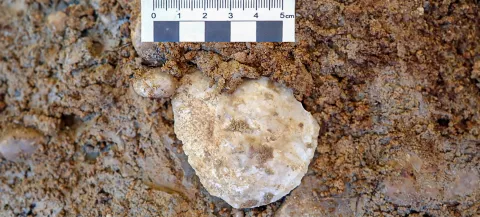
A team from Oxford Archaeology uncovered exciting evidence of ancient river systems and early human life half a million years ago.
The archaeologists were working of behalf of Oxfordshire County Council in preparation for the new A34 interchange at Lodge Hill. Discoveries made in the course of the excavations included deeply buried sediments from the area’s ancient river systems dating back to the Middle Pleistocene period and some flint tools, reflecting early human presence from this era.
Oxford Archaeology was commissioned by the councils’ contractor, Balfour Beatty, to dig 16 trial trenches, 12 test pits and two boreholes as part of a planning condition to explore any potential archaeological remains and any ancient sediments that would be affected by the new interchange.
Archaeological investigations like this are an important part of the process of delivering construction schemes. They help us identify and understand past features and residents of the area and record them for future generations. Oxfordshire has a fascinating history – not just its people, but its geology too. These remains offer a glimpse into the ancient ecosystems that existed here during the interglacial periods.”
Councillor Judy Roberts
Oxfordshire County Council’s Cabinet Member for Infrastructure and Development Strategy
Excavations found evidence of the Lodge Hill Channel, an ancient river system that crosses the site. This channel, which is buried beneath a younger layer of gravel, has silty sediments up to 5m deep in places, with remains of ancient fossil material such as snail shells, fish bones and plant matter in its deeper parts. A piece of a Palaeolithic flint handaxe was also found from deposits that directly overlap the ancient channel fill.
The channel deposits at Lodge Hill are probably part of the same river system as similar deposits found nearby, also in north Abingdon, where Sugworth Lane crosses the A34. The Sugworth Lane deposits have been recognised as of national significance for their fossil faunal remains, which contains an extinct species of vole.
Although no major archaeological remains were identified in the trenches, a few flint artefacts were also found that reflect later prehistoric human activity at the site. Three worked flints were found, probably from the Neolithic to Bronze Age periods.
Carl Champness, project manager, is very excited by these results: “The discovery of a rare lower-middle Palaeolithic age handaxe and the interglacial channel deposits at Lodge Hill dating between 600,000-500,000 years ago may provide new insights into a lost landscape. This is only the start of the story, and we hope planned further investigation and detailed analysis of these remains, will help enhance our understanding of the early occupation of Britain.”
And Palaeolithic specialist Francis Wenban-Smith of the University of Southampton, who is collaborating with Oxford Archaeology, added: “These are very exciting finds. Artefactual evidence of this period is exceptionally rare in the Upper Thames landscape north of the Goring Gap. The presence of flint tools gives an insight into the mobility of these ancient humans, since flint raw material would not have been available at the site. The human species involved was probably Homo heidelbergensis, who were the ancestor of the Neanderthals, and who periodically occupied Britain in warmer climatic episodes between c. 800,000 and 400,000 years ago.”
The archaeological evaluation also revealed a few undated features, including two small pits, a linear ditch, and a series of postholes, likely of post-medieval or modern origin, along with quantities of Roman pottery and medieval tile fragments.
